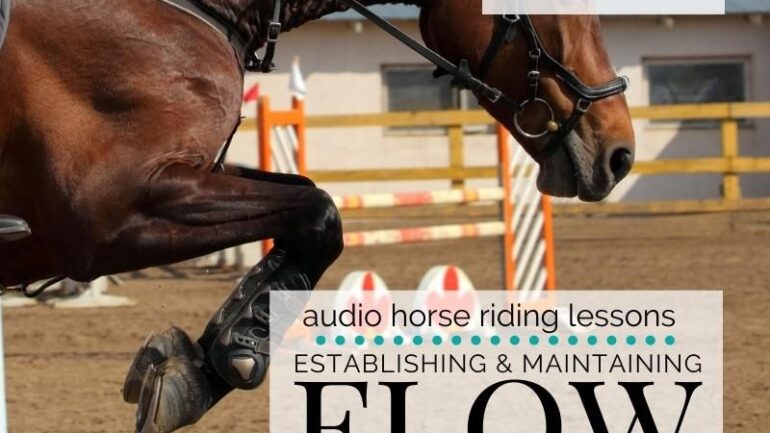Jumping is one of those things most riders love or hate. In my experience, their personal preferences depend on how well they can use the space between jumps. If every jumping track feels like a tug of war from start to finish, it’s easy to see how jumping itself won’t be all that enjoyable. The same applies if the rider feels like they are doing the work for both themselves and their very uninterested, laid-back, and uninspired horse!
One of the best ways to improve your jumping is to work on the space between jumps. This will improve the overall experience for both horse and rider…
But simply saying the space between jumps can sound a little overwhelming. After all, we really are only ‘jumping’ for a tiny amount of time. The rest is spent working inside of this ‘space’. I think there are a few key areas you can begin to improve, to help both you and your horse get more out of working over fences.
1. Get Clear on Your Track
Riding a line is something that I believe all riders need to know how to do. This is regardless of if they are riding on the flat (doing flatwork) or riding over fences. Without the ability to both see and line and remain true to the line, things will ‘wander’.
Riding a line allows you and your horse to remain focused, stay on track, reach where you want to go in the best possible way and keep energy flowing.
This is really something worth practicing. Start on the straight, and simply work on being able to ride between two points without wandering. From there, work on remaining on track both before, through, and after each corner, you ride. Finally, work on both creating a curved track and riding a curved line.
Once you feel confident riding a line, simply put poles or jumps to mark the A and B of your line, and practice using them as well.
2. Notice Weak Points
As you begin to work on your lines and make them more accurate, you might notice leaks. These leaks are where energy is being lost through the horse, rider, or both. It could be an outside shoulder that doesn’t want to connect the energy through (falling out) or maybe an inside hind leg that is finding it difficult to stay on track.
By figuring out where you and your horse are losing energy, you can work on strengthening those weaker points and, because of this, create more flow.
A good way to assess this is to first ‘feel’ the energy. Is there a corner or bend where, once you have ridden through, you find you have to do a lot to reestablish things again? Or is all the energy flowing too fast out of the front end, rather than being recycled and contained?
Once you have identified the issue (and almost all horses and riders have weak points), find exercises to help strengthen and correct this. Remember this process will take time.
3. Develop the Rhythm
When you know where you’re going and you can maintain a certain amount of energy getting there, the next step is to develop your rhythm. Whether you are working in trot or canter, maintaining a rhythm in the space between jumps can be a challenge.
Many riders experience changes in the tempo, especially on the approach to the fence. There is a quickening of the footfalls… And this can often lead to a loss of relaxation.
I think that practicing over ground poles is a great way of getting started when trying to establish and maintain rhythm. It allows the rider to simply work on the space, without actual jumps complicating the issue for them. I also like to use unrelated distances when doing this exercise. As in, two poles on either side of the arena that the rider must ride a half oval shape between.
This is also a great way to notice how relaxation (the level of tension present in horse and rider) can affect rhythm. And vice versa. By becoming keenly aware of these smaller changes, you can begin to create a more fluid, consistent, rhythm around the whole course of fences.
4. Become More Aware
The final point I want to make today is regarding you, the rider. Very often, it is actually us and what we are doing while riding in the space between jumps that are causing things to go a little awry. Getting ahead of the movement is a big issue I see many riders struggle with. Also, too much tension is present in the rider’s body. This one is often due to thoughts or beliefs that the rider has.
As you begin to more consistently model to your horse what you actually want from your horse – your horse will improve.
So, instead of worrying about what your horse is doing and ‘fighting’ him on it. Rather focus on yourself and improve your responses. Are you moving with your horse? How about tension; is the amount in your body right for the task at hand? And also position; are you in the best possible place to both communicate and support your horse?
By tidying up your riding style and basics, you can have a huge positive influence on your horse. You can also much better use the space between jumps to school and train your horse – and to get clear rounds!
Happy Riding
Lorna
- Confidently Getting Started Over Jumps
- Retraining a Horse that is Rushing Jumps
- Staying With Your Horse Over Jumps
- Learning to Wait for the Jump
- Reforming a Horse with a Habit of Running Out
- Riding a Horse with a ‘Chip In’ Habit at Take Off

